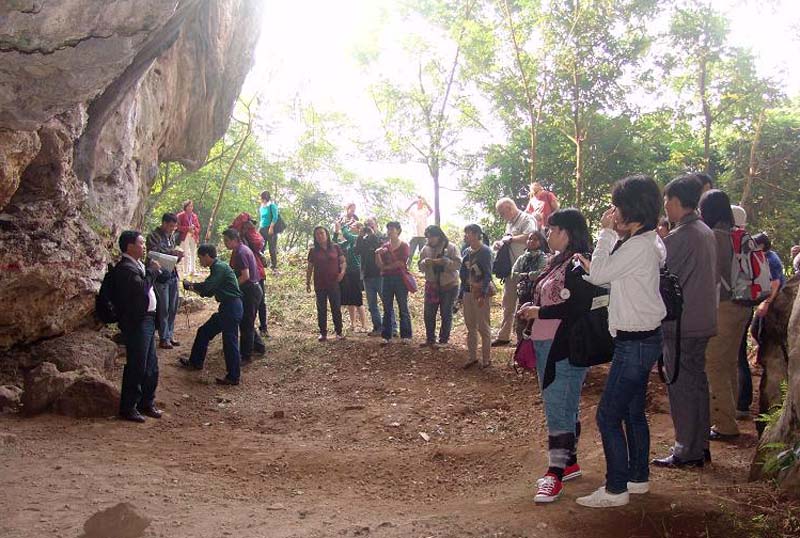
(HBO) - Hoa Binh city Currently there is a road and a hotel named Colani in Hoa Binh City. It is a tribute to the French archaeologist, Madelene Colani, who has proposed the concept of "Hoa Binh Culture” and it is also for the other generations of Hoa Binh people to know and be proud of the place where they are living, which is the cradle of "Hoa Binh Culture”.
Hoa Binh culture is a famous culture of the prehistoric period, which was 18,000 years ago. This is a typical culture in the mainland Southeast Asian countries, in southern China and in the western part of the delta of the 3 big rivers in Northern Vietnam, in which there is Da River running through the territory of Hoa Binh province.
From the excavation of relic sites of the caves in the limestone mountainous area of Hoa Binh, in 1927, the French archaeologist, Madelene Colani, proposed the concept of "Hoa Binh Culture”. Accordingly, in 1932, the first conference of Far Eastern prehistoricists meeting in Hanoi recognized the term "Hoa Binh Culture” as a term to refer to an ancient culture that appeared and existed on territory of prehistoric Vietnam, and affirmed that Hoa Binh was one of the centers of the primitive people in Vietnam.
According to the research by M.Colani: the residents of "Hoa Binh Culture” used to live in groups in caves, hunting and collecting food for a living. The people at that time knew how to use pebbles with their crafting to create almond-shaped, disk-shaped and later short ax-shaped tools.
Ms. Nguyen Thi Thi, the Director of the Provincial Museum, who has studied and unearthed the archaeological relics related to the "Hoa Binh culture” for hundreds of times says: Currently, over 130 sites under Hoa Binh culture” have been discovered in Vietnam, of which, there are over 70 relics discovered and studied in Hoa Binh. The archaeological sites belonging to "Hoa Binh culture” are mainly located in the caves and on the stone roofs.
They have been discovered in Can cave, in the cave of Trai hamlet, on the stone roof of Vong hamlet, on the stone roof of Tom, on the stone roof of Chieng Khen, in the cave of Doi hamlet, in Muoi cave and so on. These common relics in "Hoa Binh culture” is the kitchen, the burial tombs, the post-meal ruins, the labor tools and the other artifacts of the primitive people. The traces of the clam shells, snails, the animal teeth and bones, and the nut shells of some herbs have been remained in the cultural layer and a large number of relics, animal and human bones.
Currently, a number of relics are stored in the Provincial Museum. They are on the display on the occasion of the province's major holidays and they have been participating in thematic exhibits at the regional level with a view to introducing the visual images showing the steps of human evolution through "Hoa Binh Culture”. The displays on "Hoa Binh Culture” are often the simulations and reconstruction of a cave of the accommodation of the primitive people. There are the people, the fire stoves, the stone working tools, and there are a lot of shells, stone tools and pieces of scrap (eaten and left by humans) on the floor of the cave.
Proudly living in the cradle of "Hoa Binh culture”, Hoa Binh people always raise the awareness of preserving and promoting the cultural identity, creating their own characteristics of the gateway land of the Capital and the gates in the Northwest of the country.
The researchers and the students are visiting the relics of Trai cave, Tan Lap commune (Lac Son) - an excavation of the related to "Hoa Binh culture”
Phong Phu commune, Tan Lac district of Hoa Binh province, is widely regarded as the cultural heartland of the Muong ethnic group. Among its many traditional communities, Luy Ai hamlet (formerly Ai hamlet) stands out as a rare location where the customs and way of life of the Muong Bi people remain largely intact.
The Truong Kha temple festival, a distinctive cultural event held every three years in Vu Ban township, Lac Son district, returned recently with vibrant rituals and folk traditions of the Muong people. Located next to the Buoi River in the Muong Trao fields, the Truong Kha Temple is dedicated to the three Kun Dol deities, revered for teaching farming techniques, irrigation, weaving, and protecting the harvest.
The demand for spaces serving community activities of residents in various areas across Hoa Binh city has been satisfied as local cultural houses now feature modern, spacious facilities thanks to the effective implementation of Resolution No. 49/NQ-HDND issued on December 28, 2021 by the city People's Council, which approved the plan for reorganising, converting, and allocating land for the construction, repair, and expansion of cultural houses in Hoa Binh’s villages and residential areas until 2025.
At the end of May, the Hoa Binh Provincial Ethnic Arts Troupe organized a series of performances for residents in Region 2 and Region 3 communes across the province. Bringing art to ethnic communities in remote, isolated, and especially disadvantaged areas has become a meaningful activity. These are not merely artistic performances but also journeys to disseminate cultural values, enrich spiritual life, and contribute to preserving the cultural identity of ethnic minorities.



